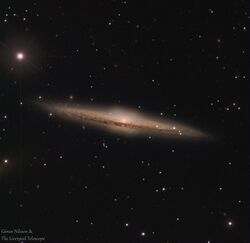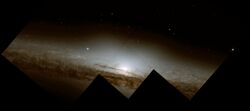Astronomy:NGC 5746
| NGC 5746 | |
|---|---|
 NGC 5746 by the Liverpool Telescope | |
| Observation data (J2000 epoch) | |
| Constellation | Virgo |
| Right ascension | 14h 44m 55.9s[1] |
| Declination | +01° 57′ 18″[1] |
| Redshift | 1724 ± 10 km/s[1] |
| Distance | 99 Mly[2] |
| Apparent magnitude (V) | 11.0[1] |
| Characteristics | |
| Type | SB(r)bc[3] |
| Apparent size (V) | 7.4′ × 1′.[1] |
| Other designations | |
| UGC 9499,[1] PGC 52665[1] | |
NGC 5746 is a barred spiral galaxy located in the eastern part of the constellation of Virgo. It is a member of the NGC 5746 Group of galaxies, itself one of the Virgo III Groups strung out to the east of the Virgo Supercluster of galaxies.[4]
Characteristics
NGC 5746 is located at a distance of 99 million light years[5] and is seen nearly edge-on, bearing a strong resemblance with the galaxy NGC 4565, that is also seen nearly edge-on.

As with the former, it has a box-shaped bulge that is actually a bar seen from one side[5] and a currently modest star formation activity.[6]
Investigations with the help of the x-ray space telescope Chandra seemed to detect a large cloud of gas surrounding NGC 5746 that was thought to be remnant gas of its formation in the process of being accreted;[7] however, later research has shown that cloud does not actually exist.[8]
Seen in the infrared, NGC 5746 also shows two pseudobulges, one nested within the other – that coincides with its central bar – as well as an inner ring with a radius of 9.1 kiloparsecs and a width of 1.6 kiloparsecs.[3]
One supernova has been observed in NGC 5746: SN 1983P (type Ia, mag. 13).[9]
References
- ↑ 1.0 1.1 1.2 1.3 1.4 1.5 1.6 "NASA/IPAC Extragalactic Database". Results for NGC 5746. http://nedwww.ipac.caltech.edu/.
- ↑ "Best distance estimate from Cosmic Flows 3 Individual Galaxy Info for UGC09499". California Institute of Technology. https://edd.ifa.hawaii.edu/get_results_pgc.php?pgc=52665.
- ↑ 3.0 3.1 Barentine, J. C.; Kormendy, J. (August 2012). "Two Pseudobulges in the "Boxy Bulge" Galaxy NGC 5746". The Astrophysical Journal 754 (2, article id 140): 140. doi:10.1088/0004-637X/754/2/140. Bibcode: 2012ApJ...754..140B.
- ↑ "The Virgo III Groups". Atlas of the Universe. http://www.atlasoftheuniverse.com/galgrps/viriii.html.
- ↑ 5.0 5.1 "Best of AOP: NGC 5746.". NOAO. http://www.noao.edu/outreach/aop/observers/n5746.html.
- ↑ Rasmussen, J.; Sommer-Larsen, J.; Pedersen, K.; Toft, S. et al. (October 2006). Investigating hot gas in the halos of two massive spirals: Observations and cosmological simulations. Bibcode: 2006astro.ph.10893R.
- ↑ Pedersen, K.; Sommer-Larsen, J.; Rasmussen, J.; Toft, S. et al. (May 2006). "Discovery of a very extended X-ray halo around a quiescent spiral galaxy The "missing link" of galaxy formation". New Astronomy 11 (7): 465–470. doi:10.1016/j.newast.2005.11.004. Bibcode: 2006NewA...11..465P.
- ↑ Pedersen, K.; Sommer-Larsen, J.; Rasmussen, J.; Toft, S. et al. (2009). "Hot Gas Halos Around Disk Galaxies: Confronting Cosmological Simulations with Observations". The Astrophysical Journal 697 (1): 79–93. doi:10.1088/0004-637x/697/1/79. Bibcode: 2009ApJ...697...79R.
- ↑ Transient Name Server entry for SN 1983P. Retrieved 29 March 2023.
External links
 |

